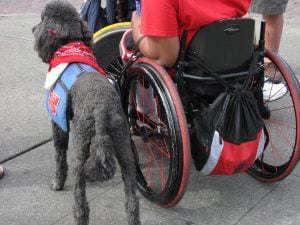
Flickr user Lisa Norwood
Some people require animals in order to navigate college (and life). Dorms, apartments, and classrooms, among other public places often allow these animals. Before we get started on what is needed to bring your service animal to college, let’s break down the two major groups of personal service animals:
Service Animals (SA)
These animals (generally dogs, sometimes miniature horses) are for people with physical disabilities. They are highly trained to do very specific tasks for their handlers, such as guiding someone who can’t see, alerting someone who is deaf, or picking things up for someone in a wheelchair. These animals can also be trained to help people who suffer from seizures, anxiety attacks, and even diabetes. Service animals are protected by the Americans with Disabilities Act (ADA), which allows them into public places with their handlers when otherwise no animals would be allowed. They are considered a medical instrument necessary to their handler’s independence and well-being.
Emotional Support Animals (ESA)
These animals (which can be just about anything) are for people with mental or emotional disabilities. They do not have to be trained; their very existence and presence is what helps their owners overcome depression, anxiety, PTSD, etc. Unlike service animals, the ADA does not protect ESAs. However, the Fair Housing Amendments Act (FHAA) does protect the owner’s right to have an ESA in a typically “No Pets” housing situation. This requires the owner to provide an ESA letter from their therapist explaining that the animal is necessary to the mental health of the individual.
Why Make the Distinction?
I wanted to note these differences early because it is an important distinction when working with your school. If you are looking to bring your SA or ESA with you to school, one of the first things you’ll want to do is to contact the school’s Office of Disability Services. While SA dogs don’t seem to have troubles, SA horses might be a little unexpected. The FHAA allows ESAs; however, some jurisdictions question whether dorms count as housing or not, so it’s best to check. You may be asked to provide documentation from your doctor/psychiatrist (this will be required for an ESA).
Having Your SA on Campus
When going around campus with your SA, it is important to remember that it must be well-behaved and tethered or on a leash at all times, unless that would hinder the animal’s ability to perform its tasks. In that case, you must maintain control through voice, signal, or other controls. It should not be disruptive during classes—with the notable exception of it performing its tasks to assist you.
Talk to your professors and scope out your classroom. Work out the best way to keep your SA in a safe and controlled environment. As with any public place, the only two questions your professors should be able to ask are 1) Is this a service animal? and 2) What work or task is it trained to perform? Your school or the city might have a voluntary registry program for people with disability SAs so that in an emergency the staff would know to look for your animal. However, they cannot mandate this.
Be Prepared
In addition, your animal will likely attract attention on campus. Even equipping it with a vest or sign that says “DO NOT PET”/”SERVICE ANIMAL” might not deter people from approaching you and either asking questions or attempting to pet the animal. Though the hope is that people will respect that your animal is on duty, there are going to be people who do not know proper etiquette concerning service animals. Prepare yourself.
Colleges Have Different Rules About ESAs
ESAs are not required to be permitted around campus. You can always ask your professors. But, emotional support animals do not have the same protection under the ADA that SAs do. This is something to keep in mind, as your ESA will spend much of its time in your dorm/apartment. The FHAA protects your right to keep your animal in your dwelling; it also can override breed restrictions, so long as the animal remains well-behaved.
Taking Care of Your SA or ESA
The benefits of service animals and emotional support animals are immense. Service animals provide a very visible service for their handlers in addition to companionship. ESAs help to relieve stress and the symptoms of psychological disorders. You have to remember that taking care of these animals requires time and energy, though. It is important to consider your animal’s needs when scheduling classes. When will they get food? Even well-trained SAs need downtime to relax. Try to avoid scheduling large blocks of classes or work so that you can go home and socialize with your ESA throughout the day and so your SA has breaks. Sticking to a routine alleviates some of the stress, both for you and the animal.
When considering whether or not to bring your animal with you to school, you should ask yourself: Will my quality of life improve enough to offset the stress that caring for an animal brings (socialization time, food costs, vet costs, etc.)? Will my animal be in a happy environment at school? Will I have enough funds to care for my animal properly? Am I responsible enough? Consider your answers to these questions carefully, as taking care of an animal by yourself is much different than sharing responsibility with your family at home.
—
Use College Raptor’s free match tool to discover individualized college matches, personalized price estimates, acceptance odds, and potential financial aid from schools around the country!







You’re information is incorrect. Service dogs are not only for physical disabilities The ADA distinguishes psychiatric service dogs from emotional support animals. A service dog is any dog who has been task trained to alleviate any disability for a disabled handler. The difference between a service dog and an emotional support animal is task training. Service dogs fulfill very specific needs for their handlers. Service dogs can be diabetic alert dogs, epilepsy dogs, PTSD dogs, autism dogs, seeing eye dogs, or mobility assistance dogs. This list is not exhaustive. Disabled handlers with service dogs have a right to public access with their service dog, regardless of the nature of their disability.
Emotional support animals receive no specialized task training. They exist purely to provide comfort. They are pets and nothing more. The owners of emotional support animals do not have a right to public access with their support animal.